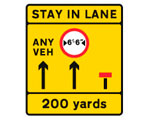 Go to main content
Go to main content
Archive Website of the UK government
Please note that this website has a UK government accesskeys system.
Main menu
Page menu
Travel and transport

Warning, regulatory, speed limit and level crossing signs

This page links to sections of the Department for Transport's 'Know your traffic signs' booklet. It gives an explanation of the signing system and covers the main types of signs, including regulatory signs that you must obey by law. Download the PDFs below for images and information on traffic signs, signals and road markings.
The signing system

There are three basic types of traffic sign: signs that give orders, signs that warn and signs that give information.
The signing system explains the shapes and colours of the signs and what they mean.
Warning signs

Warning signs tell you about hazards on the road ahead so you can look out for them and be prepared.
Regulatory signs

Regulatory signs tell you what you must and must not do. Most regulatory signs aimed at moving vehicles are round. Exceptions to this include 'stop' and 'give way' signs.
Speed limit signs

Speed limit signs are usually simple round signs, but you may also see these as part of a zone or boundary sign.
Low bridge signs

Bridges are normally signed if they are lower than 16 feet 6 inches (5 metres). The type of sign varies depending on the bridge.
Signs for road works and temporary situations

A wide range of signs are used for road works and temporary situations. These cover not just road works but lane closures, temporary speed limits, directions for works traffic and more.
Miscellaneous signs

Miscellaneous signs cover High Occupancy Vehicle (HOV) lanes, certain types of bus lane, road (congestion) charging signs and warning signs for rising bollards. This section also includes driver location signs and variable (electronic) signs.


